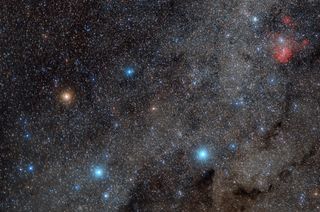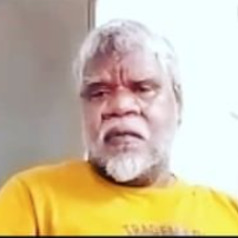
Beyond angry protesters and inked arms, there's this First Nations story of the Southern Cross — one of unity and belonging
Can the Southern Cross represent Australian identity?

This article was originally published at The Conversation. The publication contributed the article to Space.com's Expert Voices: Op-Ed & Insights.
Samuel Curkpatrick, Researcher and adjunct lecturer, University of Divinity
Sarah Bacaller, Assistant researcher, University of Divinity
Wanta Jampijinpa Pawu, Artistic director, Milpirri Festival, Lajamanu, Indigenous Knowledge
Can the Southern Cross represent Australian identity? Waved by a proud athlete or an angry protester, inked into skin or stuck to a car window, these five stars condense different aspirations, identities and histories into a recognizable symbol.
Yet such symbolism is inherently contested: from the Eureka Stockade to protests over COVID-19 vaccine mandates, or from the coat of arms to the eponymous Sydney train station, Australians have projected differing values and narratives of belonging to this constellation.
Warwick Thornton’s 2017 film "We Don't Need a Map" wrestles with racist usage of the Southern Cross, playing on a growing disquiet among many Australians who have come to associate the Southern Cross with bigotry. But Thornton also explores Indigenous narratives about the Southern Cross, suggesting the symbol can never be contained within a single defining narrative.
It is important to appreciate the diversity of identities under the Southern Cross. But we want to go further and ask: what role can the Southern Cross play in shaping an Australian identity, in which diversity coheres in a unique and life-giving way?
Reading the stars, finding our home
Through his teaching and artistic direction, Warlpiri Elder Wanta Jampijinpa Pawu asks these questions with anyone willing to hunt with him. Jampijinpa explores the meaning of the Southern Cross: a law emblazoned on the night skies since creation and read by countless generations of Aboriginal and Torres Strait Islander peoples.
Get the Space.com Newsletter
Breaking space news, the latest updates on rocket launches, skywatching events and more!
Wanta has spent decades educating young Warlpiri, especially through his innovative work as artistic director of the biennial Milpirri festival in Lajamanu, in the northern Tanami desert.
Through the Milpirri festival, Wanta and his father Jerry Jangala have drawn from rich wells of cultural identity to expound the concept of ngurru-kurlu, (Warlpiri for "home within"). Wanta understands Ngurru-kurlu to be a way of navigating identity for all who seek to live alongside one another under the Southern Cross.
Ngurra-kurlu is the essence of a people. You might call it their home. But it is more than just the ground we sleep on: we become our own home. The first three letters, ngu, mean "inner" and rra means flowing or being in motion. So ngurra is "inner flow." By adding kurlu, which means "home," or "with home," you get ngurra-kurlu.
The Southern Cross can show us how to discover our ngurra-kurlu. This is more than identity: it's also about belonging and purpose. The stars of the Southern Cross show us how our own ngurra-kurlu is bound together with the ngurra-kurlu of others.
For Warlpiri, each star of the Southern Cross represents the different skin groups that make up Warlpiri society, mapping respective stories, language, law and country.
These skin groups are:
The Southern Cross is like a map that shows us how to live alongside different people, country and ecosystems; these weave together to make our homes and sustain our identities. When we see birds, animals, plants, places, we see our families, so it reminds us of these relationships with people, the land and sky.
The little star in the Southern Cross is the wulyu-wulyu (Western chestnut mouse). That this star is off-center is a reminder to keep learning about this country and its inhabitants, to nourish one another and grow together, so that we also do not drift away.
A gift for all
The Southern Cross has deeper meanings than non-Indigenous people might realize. It is more than a symbol: for Warlpiri, it is a law that has existed since the beginning, which means we cannot claim the Southern Cross as our own but need to be reclaimed by it. By exploring its diverse meanings, we can discover those connections that sustain life in all its vibrant diversity and unity.
Sitting above us all, the Southern Cross calls us to become wantarri (a gift to one another), to become wungu-warnu (companions who are the same but different), a relationship that is a cross between family and friend. Through generous acts such as the Uluru Statement from the Heart, First Nations people have invited the rest of the nation to discover shared belonging and purpose. This has been done against Australia's backdrop of painful and violent dispossession and disrespect against First Nations people.
This invitation will continue to be shared because it is always there, written in country. Wanta teaches us there are other stories in the Southern Cross, like Jardiwarnpa, the "real" Australia Day. Jardiwarnpa takes place in the cool season after the great storms of the wet, when the Southern Cross rises from below the horizon. This is a time for reconciliation and atonement, bringing our wrongdoings and discarding them in the open, so that all might see and we might become one body of people again.
Wanta's teaching leads to the challenging yet hope-filled assertion: in all of our differences, we are called to become Australia. As we digest the knowledge from this continent, we are learning to belong to it. To learn about our respective relationships and responsibilities to one another is to become our home, which is a kind of freedom.
It is no good trying to define Australian identity through two-dimensional symbols: we must allow this country to teach us how to sit, feed and camp together under one sky.
This article is republished from The Conversation under a Creative Commons license. Read the original article.
Follow all of the Expert Voices issues and debates — and become part of the discussion — on Facebook and Twitter. The views expressed are those of the author and do not necessarily reflect the views of the publisher.
Join our Space Forums to keep talking space on the latest missions, night sky and more! And if you have a news tip, correction or comment, let us know at: community@space.com.

Professor Wantarri 'Wanta' Pawu is fully initiated into Warlpiri law and was admitted to the highest order of traditional leadership by the Warlpiri elders in 2008. He is a highly sought-after public speaker and cultural advisor of international repute, who has directed numerous films including Milpirri: Winds of Change (2014), which presently screens on SBS OnDemand. He holds long-term research collaborations with colleagues at the University of Melbourne in the Faculty of Fine Arts and Music and Faculty of Science, as well as with academics at other universities around the world.
